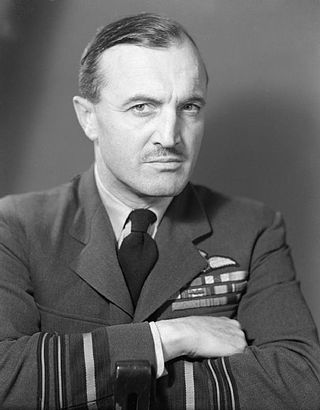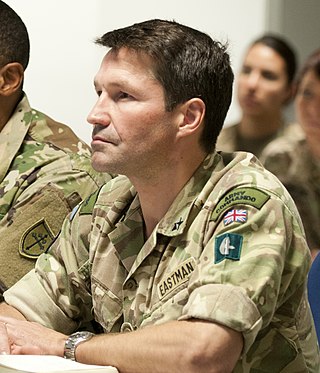
The Ministry of Defence is a ministerial department of the Government of the United Kingdom. It is responsible for implementing the defence policy set by the government and serves as the headquarters of the British Armed Forces.

The Chief of the General Staff (CGS) has been the title of the professional head of the British Army since 1964. The CGS is a member of both the Chiefs of Staff Committee and the Army Board; he is also the Chair of the Executive Committee of the Army Board. Prior to 1964, the title was Chief of the Imperial General Staff (CIGS). Since 1959, the post has been immediately subordinate to the Chief of the Defence Staff, the post held by the professional head of the British Armed Forces.

The Corps of Royal Electrical and Mechanical Engineers is the maintenance arm of the British Army that maintains the equipment that the Army uses. The corps is described as the "British Army's professional engineers".

Field Marshal Herbert Charles Onslow Plumer, 1st Viscount Plumer, was a senior British Army officer of the First World War. After commanding V Corps at the Second Battle of Ypres in April 1915, he took command of the Second Army in May 1915 and in June 1917 won an overwhelming victory over the German Army at the Battle of Messines, which started with the simultaneous explosion of a series of mines placed by the Royal Engineers' tunnelling companies beneath German lines, which created 19 large craters and was described as the loudest explosion in human history. He later served as Commander-in-Chief of the British Army of the Rhine and then as Governor of Malta before becoming High Commissioner of the British Mandate for Palestine in 1925 and retiring in 1928.

Marshal of the Royal Air Force Sir John Cotesworth Slessor, was a senior commander in the Royal Air Force (RAF), serving as Chief of the Air Staff from 1950 to 1952. As a pilot in the Royal Flying Corps during the First World War, he saw action with No. 17 Squadron in the Middle East, earning the Military Cross, and with No. 5 Squadron on the Western Front, where he was awarded the Belgian Croix de Guerre. Between the wars he commanded No. 4 Squadron in England, and No. 3 (Indian) Wing, earning the Distinguished Service Order for operations with the latter in Waziristan. In 1936, he published Air Power and Armies, which examined the use of air power against targets on and behind the battlefield.

General John Nicholas Reynolds Houghton, Baron Houghton of Richmond, is a retired senior British Army officer and former Chief of the Defence Staff (CDS) of the British Armed Forces. He was appointed CDS in July 2013, following the retirement of General Sir David Richards. He served as Commanding Officer of the 1st Battalion, the Green Howards in Northern Ireland during The Troubles and later became Commander of the 39th Infantry Brigade in Northern Ireland. He deployed as Senior British Military Representative and Deputy Commanding General, Multi-National Force – Iraq during the Iraq War. Later, he became Chief of Joint Operations at Permanent Joint Headquarters and served as Vice-Chief of the Defence Staff until assuming the position of CDS. Houghton retired from the British Army in July 2016, and was succeeded as CDS by Air Chief Marshal Sir Stuart Peach.

General Sir Charles Henry Pepys Harington, was an officer in the British Army. He served in the British Expeditionary Force and in Normandy during the Second World War. He was later Commander-in-Chief of the three-service Middle East Command from 1963 to 1965, based at Aden. He ended his military career as Chief of Personnel and Logistics at the UK Ministry of Defence from 1968 to 1971.

General Sir Charles Harington Harington, was a British Army officer most noted for his service during the First World War and the Chanak Crisis. During his 46 years in the army, Harington served in the Second Boer War, held various staff positions during the First World War, served as Deputy Chief of the Imperial General Staff between 1918 and 1920, commanded the occupation forces in the Black Sea and Turkey, and ultimately became Governor of Gibraltar in 1933.
Lieutenant General Sir Maurice Robert Johnston is a retired British Army officer. He served as Deputy Chief of the Defence Staff from 1981 to 1982, and Lord Lieutenant of Wiltshire from 1996 to 2004.
General Sir Kevin O'Donoghue, is a retired British Army officer and former Chief of Defence Materiel. He retired from the service in December 2010, being succeeded as Chief of Defence Materiel by Bernard Gray.

General Sir John Francis Martin Whiteley, was a senior British Army officer who became Deputy Chief of the Imperial General Staff (DCIGS). A career soldier, Whiteley was commissioned into the Royal Engineers from the Royal Military Academy, Woolwich in 1915 during the First World War. During the war he served in Salonika and the Middle East.

The Navy Command is the current headquarters body of the Royal Navy, and as of 2012 its major organisational grouping. It is a hybrid, neither a command, nor simply an installation. Royal Navy official writings describe Navy Command Headquarters both as a physical site, on Whale Island, Hampshire, a collective formed of the most senior RN officers, and as a budgetary grouping.

General Sir Nicholas Patrick Carter, is a retired senior British Army officer who served as Chief of the Defence Staff from June 2018 to November 2021.
Major General Patrick Claude Marriott is a former British Army officer who became Commandant of the Royal Military Academy Sandhurst.

General Sir Mark Alexander Popham Carleton-Smith, is a senior British Army officer who served as Chief of the General Staff from June 2018 to June 2022. He previously served as Director Special Forces and commanded 22 Special Air Service Regiment.

Lieutenant General Sir Mark William Poffley, is a former senior British Army officer.

Air Marshal Harvey Smyth, is a senior Northern Irish Royal Air Force officer, who has been the Deputy Chief of the Defence Staff since March 2024. Previously, he served as Air Officer Commanding No. 1 Group (2018–2020) and Air and Space Commander (2022–2024). Between February 2020 and August 2022, he took up the new post of Director Space, in the Ministry of Defence.

Lieutenant General Dame Sharon Patricia Moffat Nesmith, is a senior British Army officer. She has been Deputy Chief of the General Staff since August 2022. She became the first woman to command a British Army brigade in 2014, the first woman to command a British division-level formation in 2021, and the first woman to be promoted to lieutenant general in the British Army in 2022. She will become the first woman to be promoted to general in June 2024, when she assumes the post of Vice-Chief of the Defence Staff.

Lieutenant General David James Eastman, is a senior British Army officer. Between February 2020 and July 2022, he served as General Officer Commanding, Regional Command. In June 2024, he was appointed as the Deputy Chief of the General Staff on promotion to lieutenant general.

Lieutenant General Sir Ian John Cave,, is a British Army officer who was Commander Home Command from June 2021 to September 2023. He now serves as the UK Military Representative to NATO and to the European Union.


















